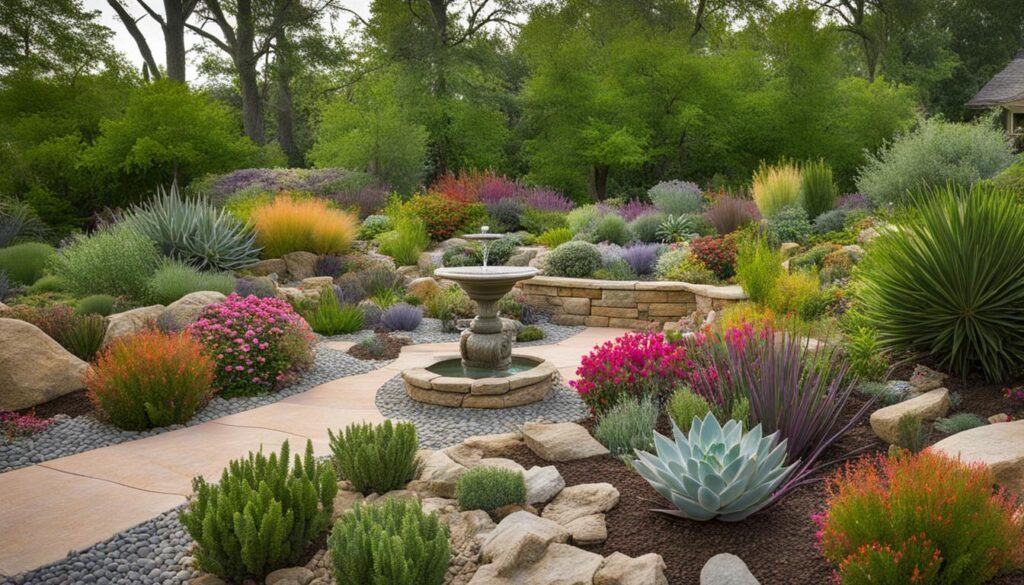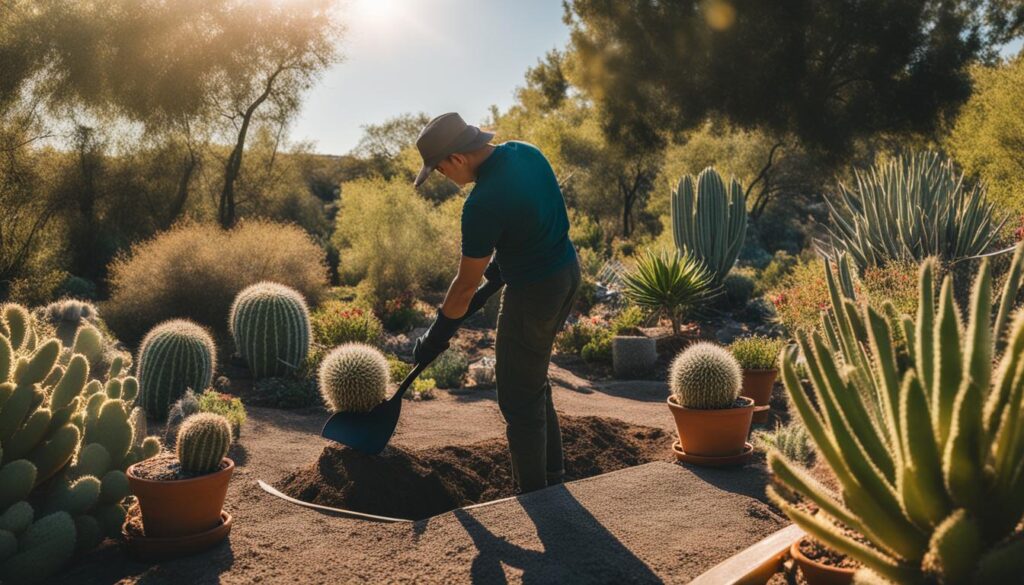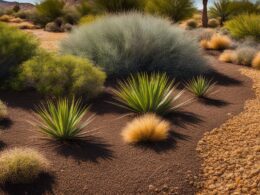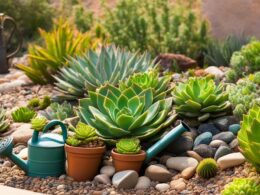Xeriscaping, a low-water gardening technique, is gaining popularity for its ability to conserve water and create sustainable landscapes, particularly in dry regions like California. Contrary to common misconceptions, xeriscape gardens can be diverse and vibrant, featuring a wide variety of plants. By incorporating native and drought-tolerant plants, homeowners can create visually appealing landscapes that thrive with minimal water usage and maintenance requirements.
Planning in advance, minimizing turfgrass, and selecting plants with lower water needs are essential principles of xeriscaping. Grouping plants with similar watering needs, using targeted irrigation systems, mulching around plants, and regular maintenance ensure the long-term health of the garden. By following these principles, you can create a beautiful xeriscape garden that not only reduces water consumption but also supports local biodiversity.
Key Takeaways:
- Xeriscaping is a low-water gardening technique that conserves water.
- Incorporating native and drought-tolerant plants is key to creating a visually appealing xeriscape garden.
- Planning, minimizing turfgrass, and selecting plants with lower water needs are important principles of xeriscaping care.
- Grouping plants with similar watering needs, using targeted irrigation systems, mulching, and regular maintenance ensure the long-term health of the garden.
- Xeriscaping with native plants supports local biodiversity and reduces water consumption.
Benefits of Xeriscaping with Native Plants
Xeriscaping with native plants offers a multitude of benefits, making it an excellent choice for sustainable landscaping. By utilizing native plant species in your xeriscape garden, you can contribute to water conservation, enjoy cost savings, and support the environment. Native plants are naturally adapted to the local climate, which means they require less water and maintenance compared to non-native species.
One of the significant advantages of xeriscaping with native plants is water conservation. These plants have evolved to thrive in their specific regions, making them highly efficient in water usage. By reducing water consumption in your garden, you can help preserve this precious resource and contribute to a more sustainable future.
Cost savings are another compelling reason to embrace xeriscaping with native plants. With reduced water requirements, you can save money on your water bills while enjoying a beautiful and thriving landscape. Native plants are also well-suited to local conditions, making them more resilient and reducing the need for costly maintenance.
Furthermore, xeriscaping with native plants offers numerous environmental benefits. Native plants attract pollinators, such as bees and butterflies, promoting biodiversity in your garden. Their deep root systems help manage rainwater runoff, preventing soil erosion and flooding. By creating a xeriscape garden with native plants, you contribute to the overall resilience of the landscape and its ability to withstand climate change impacts like droughts and increasing temperatures.
Key Benefits of Xeriscaping with Native Plants:
- Water conservation
- Cost savings
- Environmental benefits
- Enhanced resilience to climate change
“Xeriscaping with native plants allows you to conserve water, save money, and create a thriving landscape that supports local biodiversity.”
The Principles of Xeriscaping
When it comes to xeriscaping, there are several key principles that you should keep in mind to create a successful and water-efficient garden. By following these principles, you can design a visually appealing landscape that requires minimal maintenance and conserves water resources. Let’s explore each of these principles in detail:
1. Planning and Design
Before starting your xeriscape garden, it’s important to have a well-thought-out plan. Consider factors such as the layout, sun exposure, soil conditions, and the specific watering needs of different areas. By strategically placing plants based on their water requirements, you can optimize water usage and create a harmonious landscape.
2. Soil Improvement
Good soil is the foundation of a healthy garden, and this holds true for xeriscaping as well. Enhance your soil’s water-holding capacity by adding organic matter, such as compost or well-rotted manure. This improves drainage and moisture retention, allowing plants to access water more effectively.
3. Efficient Irrigation
Efficient irrigation is crucial for a water-wise garden. Consider using drip irrigation systems, which deliver water directly to the plants’ roots, minimizing evaporation and water waste. Mulching around plants also helps retain moisture and reduce weed growth, further maximizing the efficiency of your irrigation efforts.
4. Plant Selection
Choose native and drought-tolerant plants that are well-suited to your climate and soil conditions. These plants have adapted to survive with minimal water and are more likely to thrive in a xeriscape garden. Be sure to group plants with similar water needs together to make watering more efficient.
5. Maintenance
Maintaining your xeriscape garden is essential for its long-term success. Regularly monitor the health of your plants and make adjustments as needed. Prune, weed, and remove dead plants to keep your garden looking its best. By staying proactive with maintenance tasks, you can prevent issues from arising and ensure the longevity of your xeriscape garden.
By following these principles of xeriscaping, you can create an aesthetically pleasing and sustainable landscape that conserves water, reduces maintenance requirements, and supports the health of your local ecosystem. Remember to plan carefully, improve your soil, use efficient irrigation techniques, select appropriate plants, and regularly maintain your garden. With these guidelines in mind, you’ll be well on your way to enjoying a beautiful and water-wise xeriscape garden.
Xeriscaping in the Mid-Atlantic Region
The Mid-Atlantic Region experiences hot summers and periodic droughts, making xeriscaping an excellent choice for homeowners. By implementing water-conserving techniques and drought-tolerant plants, xeriscaping not only helps conserve water but also brings about a range of benefits.
Xeriscaping in the Mid-Atlantic Region promotes water conservation, which is crucial in areas prone to drought. By reducing water consumption through the use of native plants and efficient irrigation systems, homeowners can significantly contribute to conserving this valuable resource. This conservation effort not only positively impacts the environment but also results in cost savings on water bills.
“Xeriscaping in the Mid-Atlantic Region reduces water consumption, conserves resources, and saves money on water bills.”
In addition to water conservation and cost savings, xeriscaping also brings about various environmental benefits. By utilizing drought-tolerant native plants, xeriscaped gardens support local biodiversity by attracting native species, including pollinators. This promotes a healthier ecosystem and contributes to the overall well-being of the environment.
Furthermore, xeriscaping enhances the aesthetics of properties in the Mid-Atlantic Region. With careful selection and placement of native plants, homeowners can create visually appealing landscapes that enhance the overall appeal of their homes. These beautiful xeriscaped gardens not only provide enjoyment and relaxation but can also increase property value.
Benefits of Xeriscaping in the Mid-Atlantic Region:
- Water conservation
- Cost savings on water bills
- Environmental benefits, supporting local biodiversity
- Aesthetically pleasing landscapes
- Increased property value
In summary, xeriscaping in the Mid-Atlantic Region is a practical and sustainable approach to landscaping. It helps conserve water, reduces maintenance requirements, supports local biodiversity, enhances property aesthetics, and increases property value. By embracing xeriscaping with native plants, homeowners in the Mid-Atlantic Region can create beautiful and resilient landscapes that thrive in their specific climate and conditions.
Can the Native Plants for Xeriscaping also Thrive in Cold Regions?
Yes, native plants for xeriscaping can thrive in cold regions with proper xeriscape care tips for cold regions. By choosing cold-hardy native species and providing adequate insulation and mulching during the winter, xeriscaped gardens in cold areas can flourish while conserving water and minimizing maintenance.
Selecting Drought-Tolerant Native Plants for Xeriscaping
Xeriscaping with native plants offers numerous benefits for homeowners looking to create a sustainable and water-efficient garden. Native plants have adapted to the local climate, making them well-suited for xeriscaping projects in their specific region. Their natural adaptation allows these plants to thrive with reduced water requirements, making them an excellent choice for homeowners looking to conserve water and lower maintenance needs.
One of the key advantages of selecting drought-tolerant native plants for xeriscaping is their ability to support biodiversity. Native plants attract native species, including pollinators like bees and butterflies, helping to promote a healthy ecosystem within the garden. By incorporating a diverse range of native plants, homeowners can create a vibrant and ecologically beneficial landscape that enhances local biodiversity.
“Native plants have evolved to thrive in their specific environment, making them naturally low maintenance and pest-resistant.”
Low maintenance is another significant benefit of choosing native plants for xeriscaping. These plants have evolved to thrive in their specific environment, which means they require less ongoing care and are more resilient to pests and diseases. By selecting native plants, homeowners can enjoy a beautiful and thriving garden without the need for excessive watering or tedious maintenance tasks.
When choosing drought-tolerant native plants for xeriscaping, it’s essential to consider their adaptability to the local climate, reduced water requirements, ability to support biodiversity, low maintenance needs, and pest resistance. By carefully selecting a variety of native plants that meet these criteria, homeowners can create a stunning and sustainable garden that flourishes in their specific region.
Key points to consider when selecting drought-tolerant native plants:
- Choose plants that have adapted to the local climate and are well-suited for the specific region.
- Look for plants that have low water requirements, as this will help conserve water and reduce the need for irrigation.
- Consider the ability of plants to support biodiversity by attracting native species like pollinators.
- Opt for plants that are naturally low maintenance and pest-resistant, saving time and effort in garden upkeep.
Conclusion
Xeriscaping with native plants is a sustainable and practical approach to landscaping that conserves water, reduces maintenance requirements, and supports biodiversity. By following the principles of xeriscaping and selecting native, drought-tolerant plants, you can create visually appealing and resilient gardens that thrive in your specific climate and conditions.
Xeriscaping offers numerous benefits, including water conservation, cost savings, environmental advantages, and increased property value. By minimizing water usage, you contribute to the conservation of valuable water resources while saving money on your water bills. The use of native plants in xeriscaping also attracts local pollinators and supports overall biodiversity, contributing to a healthier ecosystem.
Embracing xeriscaping with native plants demonstrates your commitment to environmental sustainability and creates a beautiful and sustainable landscape. Not only do you create a visually stunning garden, but you also reduce the time and effort required for maintenance. With thoughtful planning and design, efficient irrigation systems, and proper mulching, your xeriscape garden will thrive with minimal maintenance requirements.
So, why not embrace xeriscaping with native plants and reap the numerous benefits it offers? Create a sustainable and water-efficient landscape that not only beautifies your property but also supports the environment and enhances property value. Start your xeriscaping journey today and enjoy the long-term rewards of a visually appealing and environmentally conscious garden.













